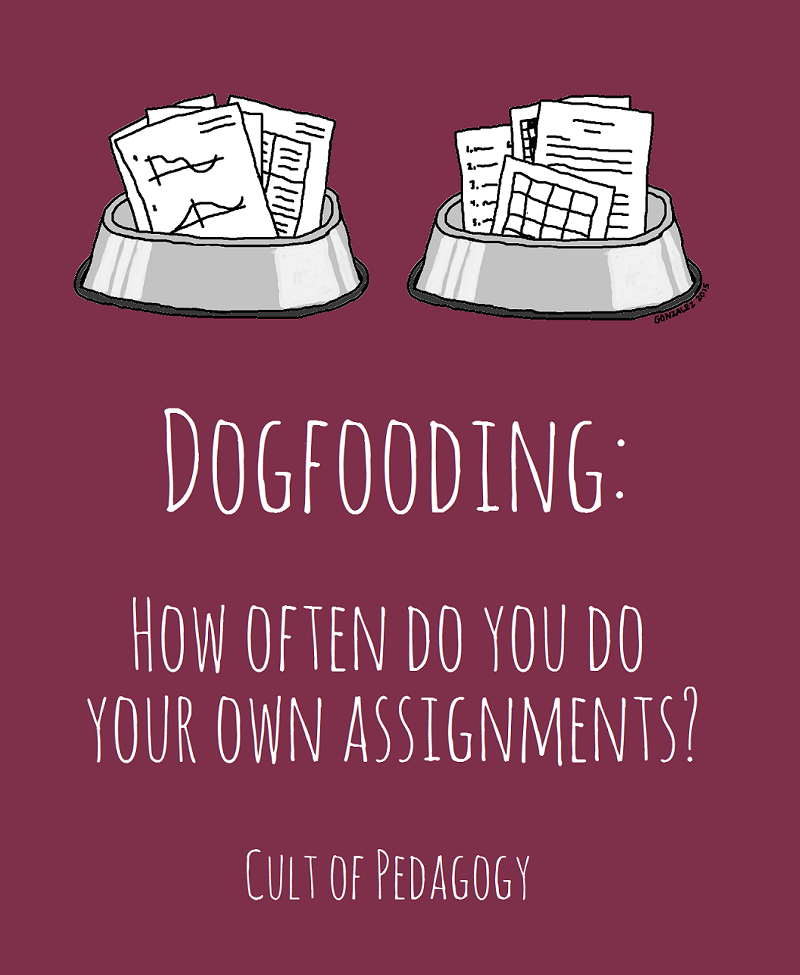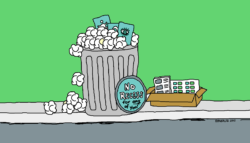Listen to this post as a podcast:
Here’s a word you may not have heard before: dogfooding. It’s a term that’s been used for years among software developers, and it refers to the act of using your own product as a consumer in order to work out its glitches, the metaphorical equivalent of “eating your own dog food.”
When a new app is created, for example, company employees will load it onto their devices and actually use it for a while to see how it operates from the user’s point of view. For many companies, dogfooding is just part of their best practices, a natural step in software development before a product is launched for consumer use.
I would like to propose that we start using this term in teaching, to make dogfooding a regular part of best practices in instructional design. This is not the first time I’ve tried to drag things from the tech world into the teaching world: Last year, I suggested we could grow more as educators by embracing the concept of teaching in beta, where we roll out a new teaching practice before it’s completely perfect, then work to improve it as we go. We can follow technology’s example again by dogfooding our lessons whenever possible. This means trying our own assignments. Taking our own tests. Doing our own homework. Attempting to actually complete those big projects. By doing this, we can detect all kind of problems that we’d never notice if we just created tasks and gave them straight to students.
Here are seven ways you can improve your practice with dogfooding:
1. Set realistic expectations.
If you’re anything like me, you tend to go a little too big in the “idea” stage of any project. So before you hand over an assignment to your students, try doing it first to make sure you aren’t asking for too much. Joanne Marks (@joannemarks), an elementary science teacher in Gulfport, Mississippi, assigned her students to research the life of a famous scientist and display their findings on a cereal box. After explaining the requirements and reviewing the rubric, she told them she would bring in an example the next day. “So I took it home and started doing the project,” she says. “I got halfway through and I was like, oh my gosh, this is way too much for the amount of time I have allowed.” She cut back on the requirements for the project and gave students a new rubric the following day. If she hadn’t taken this step, Joanne would have created a mess for herself and her students. Instead, she was able to adjust the assignment right on time.
2. Write better instructions.
Suppose you have created a task that includes step-by-step directions. Because you came up with the idea and wrote the instructions yourself, there’s a pretty good chance you missed something, some small part of a step that could create big confusion for students if you forget to include it. This would be the equivalent of failing to mention that the lid must be placed on the blender before you turn it on…obvious to anyone who has used a blender many times, but not so obvious to someone who hasn’t. So test your directions out by attempting to follow the steps exactly as they are written, or ask another person to read them to you and check to make sure you’re not filling in gaps with your own knowledge. If you want an even better test of the clarity of your instructions, have a small group of students run through them first before giving them to everyone else.
3. Troubleshoot complex activities.
When you’re planning a lab, a workshop, or some other kind of hands-on, multi-step activity, dogfooding it will help you proactively solve problems with equipment and logistics. Karen Ginsburg, a grade 7-8 science teacher in Oakland, California, is spending this summer practicing a water quality unit she will do with her students in the fall. “I will go each week and collect data as if I was a student,” she explains. “It will give me practice and experience being a student and learning as I go. What are the pitfalls? Where are the problems likely to surface? What am I really asking my students to do? Am I being realistic? Practicing something I am asking them to do is very informative!” Running through an activity like this can help you figure out how to move students through the various stages of the task without bottlenecking them in one particular spot, and because you’ll be actually using the materials, you’ll have a better sense of how to organize them for student use.
4. Get your timing right.
One common issue for teachers in the early years of their careers is timing. It takes experience to be able to accurately predict how long a learning experience is going to take, and even veteran teachers can find themselves running out of time or finishing a lesson way faster than expected. When you dogfood an activity, you can get a much clearer sense for how long it will take. I wish I had done this for a lesson I did with my pre-service teachers: To show them different possibilities for student grouping, I gave them envelopes containing tiny pieces of card stock (about the size of dimes) which I wanted them to arrange in different configurations. The idea was fine, but about five minutes into the lesson, I realized there were just too many pieces — doing each part of the exercise took way too long. If I had taken some time the night before to actually run through the exercise, I would have realized this quickly and simplified it. Because I hadn’t done that, I had to experience it the hard way, watching my students try diligently to do as I had asked, and wasting precious instructional time on something that should have taken just a few minutes to get the point across.
5. Create models.
Dogfooding an assignment allows you to build a prototype of a finished product, which can work wonders for helping students understand what’s expected of them. This is especially important with larger projects, when students will be spending days or weeks putting together the pieces of some final presentation or artifact, or when the product you have in mind is something students have never really seen. So if, for example, you would like students to write and perform satirical skits in which they parody some significant event in history, go ahead and create one yourself first. Not only will this help you better appreciate the scope of what you’re asking students to do, it will give them a much clearer target to aim for.
6. Revisit the mind of a beginner.
If you assign the kind of work to students that you yourself have been doing for years, it already makes perfect sense to you. That means you might have a hard time explaining it clearly to someone who is coming to it for the first time. Addressing this problem requires a slightly different kind of dogfooding — finding some way to approach your assignment the way a beginner would. This was the challenge for Sarah Brown Wessling (@SarahBWessling), a high school English teacher and the 2010 National Teacher of the Year. Early in her career, she had tasked her students with doing a literary analysis of The Great Gatsby, but one student just wasn’t getting it. After several one-on-one sessions with the student, including think-alouds and looking at student models, Sarah still wasn’t able to make the task clear, and the student never quite got it. “I had been asking her to do something that I could already do,” Sarah says. “I had already read The Great Gatsby. I had written papers on it. I had analyzed it. It was not hard for me. And because I couldn’t struggle along with her, I couldn’t help her.”
Determined to do a better job the following year, Sarah took a week after school let out for the summer and headed straight for the closest university library. “I didn’t pull out books on how to teach literary analysis,” she says. “Instead, I had the assignment sheet that I’d given my students, and I grabbed a book that was hard for me, a book I hadn’t read — I grabbed some Proust. I sat down with two notebooks. In one notebook I did the assignment that I’d given my students. In the other notebook, I wrote down everything my brain did as I did that assignment.” By the end of that week, Sarah had discovered a clearer approach to tackling literary analysis with her students, and was better able to explain it the following year.
7. Tweak your design.
I can’t count the number of times I have gone to fill out a form — as a student and just in regular life — and didn’t have enough room for something I had to write. I really wish more people would try completing their own forms. And who makes more “forms” than teachers? We create worksheets, tests, even online forms that may very well need some editing in their design. Attempting to complete them yourself is a simple form of dogfooding that can immediately show you when you have asked for a paragraph but only offer an inch of writing space, when you have set lines way too close together, or when you have provided way more space than is needed for an entry, which can make students question the quality of their response. It’s just a little thing, this spacing issue, but little things can add up. Once you build this into your practice, you’ll get better at spacing things right the first time around.
Although adding dogfooding to your planning process will take extra time, consider the alternative: If you don’t troubleshoot an assignment before giving it to students, you could be setting yourself up for hours of frustration as you attempt to re-teach concepts, provide time for students to re-do assignments, explain requirements to parents via phone or email, make adjustments to your schedule for activities that were timed wrong, or even deal with discipline issues that result from students just not getting what they’re supposed to do. Eating your own dogfood is time well spent, a simple way to take your practice one step closer to perfection.
Yum. ♥
Join my mailing list and get weekly tips, tools, and inspiration — in quick, bite-sized packages — all geared toward making your teaching more effective and fun. To thank you, I’ll send you a free copy of my new e-booklet, 20 Ways to Cut Your Grading Time in Half. I look forward to getting to know you better!






This is one of the best suggestions ever! Whenever I do this I am often surprised that I really am asking too much.
I was smiling as I read through your article as I have used this method from day one of my teaching career. I’m an art teacher, I can not imagine teaching any other way, I take supplies that the kids will be using in my room to create all of my assignments. I LOVE this concept being called “dogfooding” as I have four 4-legged wonders! Thanks for the connection 🙂
Thanks for this, Natalie! I love seeing the connection in art!
Great ideas. A couple more ideas: If a lesson relies heavily on technology (powerpoint, etc), make sure you practice a version of the lesson sans-tech, just in case you run into technical issues.
SUCH a smart suggestion. Thanks so much for sharing this!
This is new terminology for me, but I know from experience the value of performing a task before I present it to my students. I’m so impressed with your podcast! I’ve shared it on my blog. Check it out!
Hey! Thanks so much, Angie! I appreciate you recommending the podcast!!
You’re very welcome! I’ve learned so much from your podcasts! This is my first “Teacher Blog”, so I’m in the beginning stages. I added your podcast to my list of favorites on the blog as well. I ordered the book you recommended, Make it Stick, for the summer book study today!
Invariably when I send out an assignment or test without dogfooding (what a great term!), I find–or rather a student usually finds–some horribly illogical problem. OOPS!
The real issue I’m seeing here, however, is the importance of teachers generating their own valid materials. I can’t tell you how many times my students are surprised to find out that I write my own assessments. I was beginning to wonder if I was just some kind of masochist. Seriously, is my little corner of Educationland unique in its reluctance to produce teacher-written materials? Of course, I troll the internet for materials, purchase guides, and even use the textbook (sometimes), but those things are rarely used as-is. But the doubt on my students’ faces when I tell them that I wrote their vocabulary tests tells me that they are not used to teachers who do this.
It can take a good ten hours to write a good unit exam, but I’ve always believed it is worth it. I’ve always felt that if I’m assessing students exclusively with “store bought” materials, I’m teaching to a test, and don’t we all hate that? Writing my own assessments, to me, means that I teach my units, being responsive to each individual class, and then write assessments that fit the instruction rather than vice versa.
Tracey, I am the same way — I have almost never been able to take materials right “out of the box” and use them as is. I’ve always found the extra effort to customize things is worth it.
Something you wrote in your last paragraph got me thinking, though. It was the order you described: teaching, being responsive, then writing the assessments. I wonder if you are familiar with backward design? It’s an instructional design process that flips that order around: First, set instructional goals. Second, create an assessment that measures those objectives. Third, plan instructional activities that will help students reach the objectives. I absolutely love it — if you’ve never tried it, you may want to look at the book study I did last summer on the book, Understanding by Design, which explain how it all works.
First, I’m definitely checking out your work on Understanding by Design because I know I can stand to improve. I’ve sworn to retire when I think I can’t get any better at my job! I do see what I wrote. I am goal oriented, though setting goals and learning outcomes for each day, unit, and even course.
What I meant to convey was that in spite of planning and goals, each group of individuals responds differently, so writing my own materials allows me to respond in kind to what actually happened, not just to what I planned. For example, an end goal of studying To Kill a Mockingbird is always for students to understand what the novel’s commentary is on how individuals deal with societal pressure to conform and to relate it to something contemporary. Different groups of students connect with different characters and events and pull the discussions down different paths, so I try to focus their exam in a way that will reflect that, but still measure their understanding of the key concept.
Thanks so much for your response! This site is great, and really what I need for summer refreshment!
Yep, I got that. I think even when using the UbD approach, it’s important to be able to adjust based on what you learn about the students during instruction. You sound like a really thoughtful, deliberate kind of teacher. Your students are lucky to have you. I’m curious to hear what you think about UbD, so come back and tell me later!
I ALWAYS do my assignments because it’s how I find my mistakes. I also see where I’m going to have to tier my assignments to differentiate for varying skill levels in my classroom. Plus, as you said, it’s nice to have a finished product to show students for more complex assignments and for students who may have missed a class. For multi-day assignments where we’re doing specific steps in class each day, I sometimes keep intermediate examples so that I can show those too. I’m also delving into making videos of instructions and doing the assignments step-by-step. I think this will be helpful when students are asked to do something outside of class so that they can go back and review the steps that they may have missed or got confused on when they actually tried it.
I loved this post. I always go through the process of completing assignments before doling them out to my students, and I mention that fact to them when appropriate. Students are often dumbfounded when I say this because they cannot believe that I actually take the time to complete assignments, and my argument is, that if I’m not willing to do the work, why should they? Now I have a cool term as well, thanks! 🙂
Then Dogfooding is how I relax. Nothing better than a 5 part linear programming problem.
Ha! Brandy, this cracked me up.
This is a great strategy. I will be conducting PD webinars for CJ Faculty and will be sure to highlight dogfooding, and credit you with its connection to teaching. Thanks for another excellent thinking resource!
It took me fourteen years to finally write my own assignments, as an experienced teacher had recommended I do in year one. I started in AP Lang & Comp, to see how hard it was to write a good (level 8ish) essay in 40 minutes. What an eye-opener. Totally changed my attitude toward my students’ efforts. I really got how exhausting it is to write a timed essay, and how hard it can be to face the rest of the school day afterward. I look forward to reaping ALL of the benefits you outline above. Many thanks for a catchy new definition, too!
I love your posts and podcast Jennifer, thank you for your hard work and time explaining so many things. One of the things I love the most of being a teacher is the variety of skills we need to develop in order to be a good/great profesional. It is a very challenging job, you always have to reflect on your practices. Love to spent some time reading or listening what you post.
I love this! I have been using this strategy for the first time this year. I just moved into a role as a tech integration teacher and many of the tools I am teaching the students are new to me. This process of ‘dog fooding’ has been helpful in me working out the kinks of the assignment and to find the nuances of what teachable moments will arise.
Thanks for sharing!
I’ve been eating my own dog food since I started teaching. I found out early on that if I can’t do the lesson then it’s probably not a good lesson! It really helps me discover where the glitches are and where students might struggle. It forces me to be very clear in my instruction as well. I’m an ELA teacher and I am surprised at how many textbook lessons are inadequate or confusing. I’ve also downloaded lessons from other sites only to discover they are lacking. Every teacher should use this strategy. Thank you for sharing.
I am in my fifth year teaching secondary mathematics. And… I still do my assignments, and share my solutions to students( in that day, students pick up the writing of mathematics rather efficiently than before). I also do my quizzes and tests… to mostly get the timing, to read my own instructions and, quite unconsciously, to put myself in the beginners’ mode again.
Thanks, Jennifer! Love this idea (dogfooding) that you are creating!
🙂 Yes to all of this, Jovi! Dogfooding has saved me a zillion times – such a great practice, right? I’ll be sure to share this with Jenn.
I am a world language teacher. I do a lot of projects and writing, not a lot of “book tests”. I find it critical to do these with the students, as well. It gives me a great perspective. I don’t always share my completed project at the onset, because I don’t want carbon copies of my idea. After I dogfood, I will share my idea later on, after the students have started. Sometimes I even change mine based on what I’ve seen from my students. By dogfooding I found that some of my assessments were too grammar focused and which ended up stifling creativity. My job should be to teach communication and creativity, not just grammar. By dogfooding assignments I have found that my assessments are better at preparing them for the end goal— communication. More teachers should dogfood.
By the way I’ve been encouraging colleagues and friends to follow cult of pedagogy. It’s awesome! Danke.
Fantastic – this is great to hear, Alissa! Thanks so much for sharing.
I would like to add another reason for dogfooding. If I don’t want to do the assignment, why would my students want to do it? I noticed a lot of talk in the comments about teachers designing their own assessments and projects so they need dogfooding. I find this to be true of things I find, too. I’m not going to assign it if I am not willing to do it.
I wanted to share with you that I teach graduate and undergraduate classes at a university. This semester one of my courses was focused on integrating English Language Arts into other content areas. I instituted the Gonzalez Gem as one aspect of my class. I share one new Gonzalez idea in class each week.
As a result of my love for your ideas, I have turned an entire class of preservice teachers and my colleagues onto your common sense approach to teaching. Now, they receive your weekly emails and subscribe to Cult of Pedagogy, too!
This 2015 post about dogfooding your assignments is one I was able to share with my students before COVID made it impossible to meet in person. I love this article and have followed this advice during my 33 years as an English educator and administrator. Now, in my second career as an education professor, I have the joy of spreading the Gonzalez gospel to a new generation of teachers! Thank you for providing this service!
This is so important! I found an awesome and creative logic puzzle online to use in one of my classes this week…or so I thought. When I tried doing it myself (just using the clues, none of my prior knowledge on the topic), it took me ages to solve it and I was still left with a few facts I couldn’t piece together! If I couldn’t solve it to save my life, there’s no way my 7th-graders could do it. It was so frustrating to scrap that after I’d spent so long on it, but my headache would’ve been sooo much bigger had I actually assigned it and had to deal with countless questions from frustrated students. I’m so glad I dogfooded it so I knew to find a simpler version!
I just listened to your podcast. I am excited that there is a term for this… along with beta teaching. Who knew? I’ve been in post-secondary education for 20+ years and a curriculum specialist at least half of this time and, while these practices have been part of my typical repertoire, it’s cool to have a name for them. I’ll be going to check out your website for more goodies. Thank you very much for sharing. I’ll do the same and share this concept in my networks. Cheers! Larry in Vancouver, Canada.
I love this strategy! Dogfooding offers so many great suggestions for educators to practice that will enhance their lesson. My favorite suggestion was number 6, to revisit the mind of a learner. It was inspiring to hear the actions from Sarah Wessling. She admitted her faults and took the time out of her summer to better help her students. However, I think that each suggestion is great quality and teachers should take advantage of these ideas. Although, it does take a little extra time. It is completely worth it in the end.